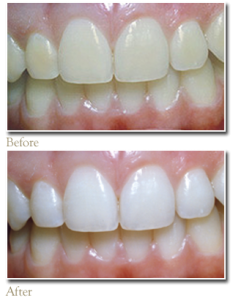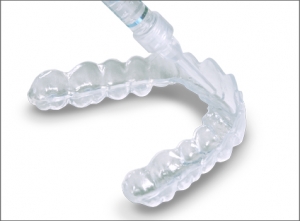Star of Texas Dental Assisting School teaches all of its Austin dental assisting students the key components to a successful dental career. Our students receive the most advanced training in both general and specialty dental assisting.
Let’s first take a look at general & cosmetic dentistry.
Teeth Whitening
 The least damaging and most conservative way of making your teeth lighter is with the use of a whitening solution. Contrary to what you might think, brushing your teeth harder with an abrasive toothpaste will not make your teeth whiter, but rather may darken them faster. The tooth-whitening concept has been around for many years, and the techniques have become easier and less expensive to accomplish. Tooth whitening was noted in the dental literature in the 1920’s. The technique has become easier and the cost has decreased. Today, there are two convenient methods to whiten dark teeth: At-Home Whitening and In-Office Whitening.
The least damaging and most conservative way of making your teeth lighter is with the use of a whitening solution. Contrary to what you might think, brushing your teeth harder with an abrasive toothpaste will not make your teeth whiter, but rather may darken them faster. The tooth-whitening concept has been around for many years, and the techniques have become easier and less expensive to accomplish. Tooth whitening was noted in the dental literature in the 1920’s. The technique has become easier and the cost has decreased. Today, there are two convenient methods to whiten dark teeth: At-Home Whitening and In-Office Whitening.
Why Do Teeth Get Yellow?
The intrinsic (normal) color of your teeth is related to the color and thickness of the enamel and dentin, as well as the types of foods and liquids you ingest. The thinner the enamel, the darker the underlying dentin; the more coffee, tea, cola beverages, and red wine you drink, the darker your teeth will be. Cracks that are commonly found in the enamel of your teeth may provide a pathway for discoloring fluids to reach the underlying dentin.
If you have a yellow, brown, or orange shade to your teeth, in most cases it can be made lighter by the whitening procedure. Whitening works very well in removing age-related darkening of your teeth. This age-related darkening is most likely due to years of drinking the darkening beverages, or other environmental factors, rather than genetics. No drilling or anesthesia is required for whitening. Your teeth will not become weaker. Because the mineralization of teeth varies so much from person to person, there is no way to determine how many office visits it will take to effect the color change or how white the teeth will get. The darker your teeth are, the more time required for the change and the more distinctive the color change will be.
The whitening procedure will also work to a lesser degree on teeth with tetracycline discoloration. There has been several fair to good results from both in-office and at-home whitening. It does take more time to achieve good results on this type of stain, and unfortunately, sometimes the change is minor.
Two Available Techniques
There are two types of whitening available. One is done by the  patient at home, and the other is done by your dentist during an office visit. They can be done separately or in conjunction with each other. The at-home technique involves using a soft, thin, comfortable mouthguard-like tray. An impression is made of your teeth, and the custom whitening trays are fabricated. Then at home, you place the whitening solution in the trays and wear them for an hour or two each day or sleep with them in place all night. With in-office whitening, you come to the office for 1 or 2 hours, and a stronger whitening solution is applied by your dentist and activated for that time. Usually only one visit is required.
patient at home, and the other is done by your dentist during an office visit. They can be done separately or in conjunction with each other. The at-home technique involves using a soft, thin, comfortable mouthguard-like tray. An impression is made of your teeth, and the custom whitening trays are fabricated. Then at home, you place the whitening solution in the trays and wear them for an hour or two each day or sleep with them in place all night. With in-office whitening, you come to the office for 1 or 2 hours, and a stronger whitening solution is applied by your dentist and activated for that time. Usually only one visit is required.
The color change should last for 3 to 7 years in most people. The color change you see immediately after the whitening is completed will regress one shade over the course of 1 to 3 months, with most of the change taking place in the first week. If you drink a lot of coffee, tea, cola beverages, red wine, or if you smoke, the teeth may begin to turn darker again. When this happens, the whitening process can be repeated.
The possible side effects include temporary white discoloration of the gum tissue if the office whitening solution comes into contact with the gum. This goes away quickly. The teeth may become slightly sensitive to temperature changes for a short time. This also goes away quickly. There is no damage to the tooth enamel, dentin, or pulp from the whitening process. Fillings and crowns do not whiten. When your teeth change to a lighter color, you may need to have those fillings and/or crowns redone. Your dentist will let you know whether this is a possibility before they whiten your teeth. There are no other adverse effects known.
The teeth that show when you talk, smile or eat are the teeth that would benefit your appearance most if whitened. Usually the top teeth are whitened because they are much more visible than the bottom teeth, but both arches can be successfully whitened. The lower teeth take about three times as long to reach the color change of the top teeth.
We are all smiles about our next session beginning on September 12th! Call Star of Texas Dental Assisting School today to enroll in the best dental assisting program in Austin! (512) 487-1547

